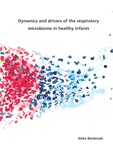Dynamics and drivers of the respiratory microbiome in healthy infants

Biesbroek, Giske
- Promoter:
- Prof.dr. E.A.M. (Lieke) Sanders
- Co-promoter:
- Dr. D. (Debby) Bogaert
- Research group:
- Sanders
- Date:
- May 22, 2014
- Time:
- 14:30 h
Summary
Respiratory tract infections are a major cause of mortality and morbidity worldwide, mostly affecting the very young. Although carriage of potential pathogens (pathobionts) in the respiratory tract is an important prerequisite for infection, it remains unclear what mechanisms define whether carriers progress towards disease. Through innovative sequencing techniques we know we are colonized not only by pathobionts but by in total, more than 1 trillion bacteria, the so called microbiome. These bacteria have a beneficial function to us: they mature our immune system and mucosal barriers and help resist colonization by pathogens. Subsequently, changes in bacterial community characteristics like types or relative amounts of bacteria present and changes in their functional ability are increasingly associated with disease. Since the microbiome might also play a role in the aetiology of respiratory infections, we aimed to obtain a better understanding of bacterial community characteristics in the respiratory tract of young children. We characterized the microbiota of approximately 800 nasopharyngeal samples obtained from children at the ages of 1.5, 6, 12 and 24 months. The major finding of this thesis is that distinct microbiota profiles already exist early in life, which are associated with microbiota stability and change over time. More stable patterns were marked by a high presence and abundance of Moraxella and Dolosigranulum/Corynebacterium, and less stable profiles by a high presence and abundance of Haemophilus and Streptococcus. In addition, the presence of S. pneumoniae and H. influenzae as detected by culture was positively associated with the presence of respiratory viruses in general and with human rhinoviruses specifically. A second important finding was that breastfeeding was strongly associated with microbiota composition, especially the increased presence and abundance of commensal residents like the lactic acid producing bacterium Dolosigranulum and Corynebacterium. Finally, this thesis provides first clues that microbiome profiles correlate with respiratory health characteristics. Stable profiles and the presence and abundance of Dolosigranulum were negatively correlated to symptoms of wheezing and respiratory tract infections experienced in the first 6 months of life. These findings are important for understanding the development and cohesion of the respiratory microbiome in the first years of life and provide clues for healthy or susceptible conditions for respiratory tract infections. These insights can lead to alternative diagnostic, therapeutic and preventive surveillance strategies in respiratory infections. Better understanding of the aetiology and individual susceptibility to respiratory tract infections is essential for untangling this major health problem in children.